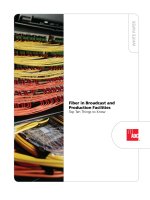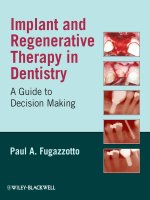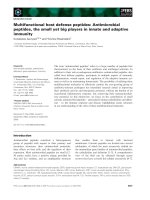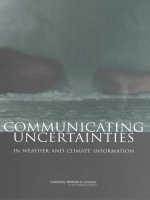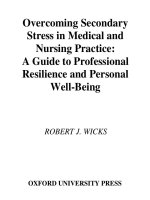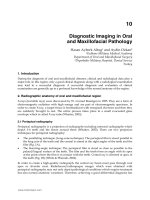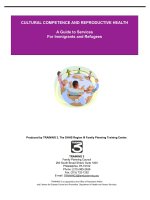Overcoming Secondary Stress in Medical and Nursing Practice: A Guide to Professional Resilience and Personal Well-Being docx
Bạn đang xem bản rút gọn của tài liệu. Xem và tải ngay bản đầy đủ của tài liệu tại đây (1010.49 KB, 214 trang )
Overcoming Secondary
Stress in Medical and
Nursing Practice:
A Guide to Professional
Resilience and Personal
Well-Being
ROBERT J. WICKS
OXFORD UNIVERSITY PRESS
Overcoming Secondary Stress
in Medical and Nursing Practice
This page intentionally left blank
Overcoming Secondary Stress
in me dical and nur sing practice
A Guide to Professional Resilience
and Personal Well-Being
rob e rt j. w i c k s
3
2006
3
Oxford University Press, Inc., publishes works that further
Oxford University’s objective of excellence
in research, scholarship, and education.
Oxford New York
Auckland Cape Town Dar es Salaam Hong Kong Karachi
Kuala Lumpur Madrid Melbourne Mexico City Nairobi
New Delhi Shanghai Taipei Toronto
With offices in
Argentina Austria Brazil Chile Czech Republic France Greece
Guatemala Hungary Italy Japan Poland Portugal Singapore
South Korea Switzerland Thailand Turkey Ukraine Vietnam
Copyright © 2006 by Oxford University Press, Inc.
Published by Oxford University Press, Inc.
198 Madison Avenue, New York, New York 10016
www.oup.com
Oxford is a registered trademark of Oxford University Press
All rights reserved. No part of this publication may be reproduced,
stored in a retrieval system, or transmitted, in any form or by any means,
electronic, mechanical, photocopying, recording, or otherwise,
without the prior permission of Oxford University Press.
Library of Congress Cataloging-in-Publication Data
Wicks, Robert J.
Overcoming secondary stress in medical and nursing practice :
a guide to professional resilience and personal well-being / Robert J. Wicks.
p. cm.
Includes bibliographical references and index.
ISBN-13 978-0-19-517223-2
ISBN 0-19-517223-X
1. Physicians—Job stress. 2. Nurses—Job stress. 3. Medical personnel—Job stress.
4. Physicians—Mental health. 5. Nurses—Mental health. 6. Medical personnel—Mental health.
7. Burn out (Psychology)—Prevention. 8. Resilience (Personality trait). 9. Self-care, Health.
10. Stress management. I. Title.
[DNLM: 1. Burnout, Professional—prevention & control. 2. Allied Health Personnel—
psychology. 3. Nurses—psychology. 4. Patient Care—psychology. 5. Physicians—psychology.
WM 172 W637o 2005]
R707.W535 2005
610.69'01'9—dc
2004026508
9 8 7 6 5 4 3 2 1
Printed in the United States of America
on acid-free paper
For the students, staff, and faculty of Stritch School of Medicine and
Wright State School of Medicine and the nurses in my family and
close circle of friends—
My wife Michaele Barry Wicks
My sisters-in-law Deborah Kibble and Margaret Wicks
My cousins Ruthanne Croal, Annemarie Belanger, Helen Sue
McNamara, Mary Kate O’Brien, and Nancy Keating
My nieces Christine Candio and Chemin Malone
and
My close friends, who were also classmates of my wife at St. John’s
School of Nursing—Susan Ferraro and Dorothy Sicinski
This page intentionally left blank
Foreword
D
enial is one of the best-developed coping reflexes in health care
workers, particularly in physicians and nurses. It exists on several
levels, and it is provoked by a number of different but related dynamics.
Most of us in health care—in the profession of caring for patients—
have thought of denial as a self-protective reaction, a shield against the
emotional and psychic turmoil of the environment in which we work.
And for physicians and nurses, where they work is essentially where
they live.
It is a well-worked and commonly described dynamic. It is also
oversimplified in its construct and terribly underestimated for its impact
on the caregiver’s personal well-being and day-to-day effectiveness.
There are two levels of denial that deserve particular comment in anticipating the content of this work by Dr. Robert Wicks.
Physicians and nurses are typically trained in hospital settings that
afford them exposure to and experience with a remarkable constellation of seriously ill patients. Few of those patients occupy a hospital bed
for relatively minor medical problems. In fact, as our health care system
has evolved in the United States, the severity of patients’ illness in hospital has intensified as everything that is less severe, non-life-threatening,
is relegated to nonhospital sites of care. The hospital setting has always
been “intense,” but over the past years it has become frighteningly,
breathtakingly so.
viii
Foreword
In many hospitals, patients are grouped by clinical discipline—nursing units that consist of all cancer patients, all patients with neurologic
diseases, all patients awaiting or having had organ transplantation, and so
on. The result is to produce a remarkable concentration of incredibly ill
patients whose lives and families are in understandable disarray.
This is the world of physicians and nurses and the reality into which
they are immersed from their earliest days of training. It is a world of
disease-afflicted lives lined up person-after-person, room-after room in
which the physicians and nurses seem to be the only ones spared. Hardly
a minute’s respite separates one heart-rending, gut-wrenching circumstance from the next. And through this minefield of random misfortune
walk the caregivers as if guided by guardian angels, apparently unscathed.
Who among us has not identified with the young leukemia patient
who is refractory to treatment and scared to death, or the midcareer
professional deeply unresponsive and too young to have had this massive stroke, or the parents trying to absorb into their consciousness the
sudden, accidental death of a child? Instead of the afflicted’s “Why me?”
the caregiver’s frightened imponderable becomes “Why not me? What
roll of the dice, what act of fate, what divine intervention preserves me
from any one of these circumstances?”What makes it possible for physicians and nurses to confront these patients and circumstances day after
day with caring and therapeutic resolve and to walk the balance beam
between the paralyzing fear of their own mortality and the numbness
of emotional disengagement or indifference? And while the hospital
environment is the epicenter of personal exposure, the reminders are
distributed throughout one’s day from office visits with patients to telephone calls with distraught family members. In each encounter, we see
ourselves separated from our patients’ circumstances by the luck of the
draw but believe at a subconscious level that we are somehow protected.
It’s like wearing a Red Cross arm badge in the battlefield.
There is something self-protective in this construct to be sure. But
in fact our effectiveness as physicians and nurses, our value as caregivers
resides in the care of the whole person. The ability to do that depends
on our ability to empathize with our patients, to see ourselves in our
patients. And that, of course, demands that we confront our vulnerability and the statistical likelihood that we, too, will experience the misfortune of illness and its life-changing implications.
To work that through, to reconcile our vulnerability with the need
to insulate ourselves from harm, to use that reality to become more
Foreword
ix
effective caregivers requires energy and self-awareness. To fail to do so
is a set-up for another level of denial—the inability to appreciate or the
refusal to admit the psychological, emotional, and spiritual “wear and
tear” of one patient interaction after another. In many ways, patient care
is as consumptive for physicians and nurses as illness is for patients. At
some point, both parties to the clinical engagement need rest, restoration, and rejuvenation of body and spirit to continue to be effective and
useful and, most important, fulfilled. Recognizing this fact, admitting it,
and doing something about it require a different level of self-awareness.
It is a fascinating dilemma of patient care that promotes emotional
detachment as the platform for rational clinical decision-making but
that recognizes identification with patients as the basis for real empathy.
The former is almost always achieved only on a conscious, volitional
level. The latter is the state to which the good physician or nurse is
drawn and strives to achieve.These are complex and traumatizing forces
at work.
It is precisely to this circumstance that Robert Wicks applies his
keen understanding and insight. Wicks is a clinician whose first-hand
knowledge of the patient-caregiver encounter is tell-tale. He understands the environment in which these encounters occur. He understands how physicians and nurses think and, more important, how they
feel and articulates both with disarming clarity. Wicks knows his audience and the hazardous world in which they work, and his characterizations of compassion fatigue, burnout, and stress are real-world.
But the description of the problem is not where this book’s major
contribution lies. Its real value begins with recommendations for assessing the status of one’s emotional reserves—or lack thereof—and what
to do about it. Wicks holds up a large mirror and walks the observer
through a personal inventory using his wisdom and insight as the reader’s guide. It is difficult for a physician or nurse to read this book and not
feel that the author knows more about you than he should.
This is not a book about self-help. It is a book about self-rediscovery and self-rejuvenation.
Anthony Barbato, M.D.
President, Loyola University Health System
This page intentionally left blank
Acknowledgments
A
s with any project, there are so many people to thank for their
suggestions, encouragement, and support. In particular, I would
like to thank my colleague Beverly E. Eanes, Ph.D., R.N., for her recommendations about self-care from a nursing perspective; psychiatrist
Thomas Cimonetti, M.D., for his reflections on physician stress; Sally
Cheston, M.D., for her suggestions on dealing with stress in the radiology/oncology outpatient setting; Anthony Barbato, M.D., for taking
out time from his demanding schedule as president of Loyola University Health System in Chicago to write the Foreword to this project;
Karyn Felder, my graduate assistant, for aiding in the research and typing; Samuel LaMachia for finding out-of-print books so I could appreciate the long history of writing on the topic of medical/nursing practice and secondary stress; Joseph Ciarrocchi, Ph.D., who as colleague,
friend, and department chairperson wholeheartedly supported this
project from its inception; James Buckley, Ph.D., Dean of Arts and Sciences, Amanda Thomas, Ph.D., Associate Dean, and the Faculty Development Committee of Loyola College in Maryland for providing me
the time and resources to complete the research and write this book;
and, of course, my wife, Michaele Barry Wicks, R.N., who made many
invaluable suggestions with respect to content, nuance, and editorial
presentation of the manuscript—I can’t thank her enough for all she
did and, more important, who she is.
This page intentionally left blank
Permissions
I am grateful for the following permissions to use previously copyrighted material:
Excerpts from Managing Stress in Emergency Medical Services by Brian
Luke Seaward/American Academy of Orthopaedic Surgeons. Copyright © 2000 Jones and Bartlett Publishers, Sudbury, MA. www.jdpub
.com. Used with permission of the publisher.
Excerpts from Riding the Dragon by Robert J. Wicks. Copyright © 2003
Sorin Books, an imprint of Ave Maria Press Inc., Notre Dame, IN.
www.avemariapress.com. Used with permission of the publisher.
Excerpts from Simple Changes by Robert J. Wicks. Copyright © 2000
Thomas More Publishing, an imprint of Ave Maria Press Inc., Notre
Dame, IN. www.avemariapress.com. Used with permission of the
publisher.
Excerpts from Touching the Holy by Robert J. Wicks. Copyright © 1992
by Ave Maria Press, Notre Dame, IN. www.avemariapress.com. Used
with permission of the publisher.
xiv
Permissions
Excerpts from Clinical Handbook of Pastoral Counseling, Volume , edited
by Robert J.Wicks, R. Parsons, and D. Capps. Copyright © 2003 Paulist
Press, Inc., New York/Mahway, NJ. www.paulistpress.com. Used with
permission of the publisher.
Excerpts from Handbook of Spirituality for Ministers, Volume , edited by
Robert J. Wicks, © 1995, Paulist Press, Inc., New York/Mahwah, NJ.
www.paulistpress.com. Used with permission of the publisher.
Excerpts from Living a Gentle, Passionate Life by Robert J. Wicks.
Copyright © 1998, Paulist Press, Inc., New York/Mahwah, NJ. www
.paulistpress.com. Used with permission of the publisher.
Excerpts from Living Simply in an Anxious World by Robert J. Wicks.
Copyright © 1988, Paulist Press, Inc., New York/Mahwah, NJ. www
.paulistpress.com. Used with permission of the publisher.
Excerpts from After : Spiritually Embracing Your Own Wisdom Years by
Robert J. Wicks. Copyright © 1997, Paulist Press, Inc., New York/
Mahwah, NJ. www.paulistpress.com. Used with permission of the
publisher.
Contents
Foreword
Anthony Barbato, M.D. vii
Introduction. Reaching Out . . . Without Being Pulled Down:
Remaining Passionate in the Fields of Medicine,
Nursing, and Allied Health—A Guide to Personal and
Professional Well-Being 3
Chapter 1.Tacking On Dangerous Psychological Waters:
Appreciating the Factors Involved in Chronic and Acute
Secondary Stress 14
Chapter 2.“Riding the Dragon”: Enhancing Self-Knowledge and
Self-Talk in the Health Care Professional 47
Chapter 3. Drawing from the Well of Wisdom: Three Core Spiritual
Approaches to Maintaining Perspective and Strengthening
the Inner Life of the Physician, Nurse, and Allied Health
Professional 84
Chapter 4.The Simple Care of a Hopeful Heart: Developing a
Personally Designed Self-Care Protocol 113
xvi
Contents
Epilogue. Passionate Journeys: Returning to the Wonders of Medicine,
Nursing, and Allied Health 140
Bibliography
Index
189
147
Overcoming Secondary Stress
in Medical and Nursing Practice
This page intentionally left blank
introduction
Reaching Out . . . Without Being Pulled Down
Remaining Passionate in the Fields of Medicine,
Nursing, and Allied Health—A Guide to Personal
and Professional Well-Being
T
his book is written for psychologically healthy physicians, nurses,
and allied health professionals. It is designed to alert them to the
sources of secondary stress and provide ways to strengthen their inner
lives. In the modern health care setting, knowing this information is
not simply desirable; it is essential for one’s personal and professional
well-being.
If there is an apt proverb for the articulated and unspoken demands
many people make of physicians, nurses, and allied health professionals
today, it surely must be the Yiddish one: “Sleep faster. . . . We need the
pillows!” As physician Simon Brown from the United Kingdom notes
in his paper, “The Stresses of Clinical Medicine”:
Perhaps you are thinking that this is the bit that we can all do—
the “nuts and bolts” clinical doctoring part of medicine. We all
know how stressful the politics of changing health service has
been and is likely to continue to be. We all face a daunting
uphill struggle against piles of paper, the clock, increasingly
demanding patients, complaints, managing our practices and
doing more and more for less—just to name but a few of our
demons. But the clinical medicine is surely the enjoyable bit
where our training takes over and tells us what to do, even in
a crisis. After all we are doctors, aren’t we?
3
4
Overcoming Secondary Stress in Medical and Nursing Practice
Of course, the reality of day-to-day clinical practice is different. Despite the training we have already received, there is a
disparity between what we achieve and what is expected of us.
This gap between supply and demand, both physical and psychological, is an inevitable part of life, let alone work in today’s
primary care. This is the stuff of stress, the lynchpin of potential unhappiness unless we are able to understand and resolve
the difference for ourselves as people, GPs and the profession
as a whole. This is an important process. . . . If we get it right,
we may just feel contentment in a job well done.1
Certainly these comments ring true in different ways for all health care
professionals today.
Furthermore, as well as unrealistic expectations on the part of
patients and health systems, the stakes are now so high for health care
professionals that the potential for developing such psychological problems as emotional blunting on the one hand or extreme affectivity on
the other is quite great. Many deny their own emotional needs as a
survival mechanism. However, physicians, nurses, and allied health professionals who follow the implicit advice to protect themselves by not
allowing themselves to feel too much emotion, sympathy or sadness,
run the risk of shutting down entirely in the process.
And so, in their contact with patients, not only may healing professionals contract a physical disease, they are also in an even greater
danger of being “infected” psychologically. Secondary stress, the pressure
that results from reaching out to others in need, is a constant and continuous, reality in medicine, nursing, and allied health. The problem has not
disappeared today. It has, in fact, remained a situation to be reckoned
with in new ways.
Stress from unfortunate changes in the health care environment,
world instability, the internal pressures that result when caring professionals become overwhelmed by frustrations, and the loss of perspective
when encountering the inevitable failures of being involved in life and
death situations make up only part of a psychologically-combustible
mixture. Therefore, to not address this is not only foolish; it is also dangerous to the well-being of a talented, caring, and hitherto emotionally
healthy person working in the healing professions—the audience for
whom this book is written.
Reaching Out . . . Without Being Pulled Down
5
This Book’s Framework
Overcoming Secondary Stress in Medical and Nursing Practice is a “onesitting book” that is designed to distill current clinical papers and
research; provide proven guidelines to avoid and/or limit unnecessary
distress; strengthen the inner life of physicians, nurses, and allied health
personnel; and offer recommendations for further reading on the topic.
If nothing else, its goal is to raise awareness that secondary stress is a
serious danger. The denial and avoidance of dealing with the immense
stress present in modern health care today are amazing. Professionals
seem so discouraged at times that they do not even consider—given
the culture and their own personal resources—that there are possible practical approaches to deal with environmental and intrapersonal
sources of stress in health care settings. Instead, unfortunately, they just
march on.
When I had a session with one very competent professional who
was starting to manifest early symptoms of chronic secondary stress
such as hypersensitivity, increased daily use of alcohol, and sleep disturbance, I asked him how he would characterize his own problem. He
said, “I may not be burned out yet.” Then, after a brief pause, he smiled
slightly and added,“But I think I’m experiencing at least a ‘brown out’!”
Acknowledging his insight, I asked that given the precarious situation
in which he recognized himself, what type of self-care protocol did he
design for himself and use to prevent further deterioration of his emotional well-being? In response, after sighing, he said, “I only wish I had
the time for something like that!”
Time, of course, is so limited for nurses, physicians, and allied health
professionals. More and more I am aware of this even in my own life.
Shortly after I received my doctorate from Hahnemann Medical College, a physician who had one of the busiest practices in the area came
in for an initial psychological assessment. He was having an affair outside of his marriage. Being a new graduate, I remember carefully formulating a Freudian theoretical diagnosis in my mind. If he were to
come in to see me now, though, I must confess that I think my first
reaction would be, “Where does he get the time?”
For health professionals, time is especially precious. In response,
they need to schedule their priorities and ensure that what is done is
accomplished in the most effective way possible. Overcoming Secondary
6
Overcoming Secondary Stress in Medical and Nursing Practice
Stress in Medical and Nursing Practice is designed with these realities and
practices in mind.This book is a beginning. Nothing more. But a necessary beginning, nonetheless.Without a clear awareness of the challenges
of professional health care and the simple, yet powerful, ways to remain
a passionate, psychologically healthy nurse, physician, or allied health
professional and appreciate the need to strengthen one’s “inner life,”
one’s career may become derailed and one’s personal life unduly suffer.
This book, as a whole, is presented in a way that provides information that will quickly enable a sufficient appreciation of the essential
elements of the problem. Most of these will be obvious; some may
prove quite surprising. Following this, guidelines for the development
of a personally designed self-care protocol will be provided, as well as
information on maintaining perspective and increasing self-knowledge
as a way of learning and benefiting from, rather than just being pulled
down by, the stressful encounters that will certainly arise.
A major portion of the research and clinical papers over the past 10
years and related books released in the past 25 years have been reviewed
in the preparation of this volume. The bibliography in this volume is
one of the most extensive and current lists that can be found in any
book on this topic published to date. This invaluable material provides
grounding for my almost 30 years of clinical experience with physicians,
nurses, and allied health professionals. Beyond what is written in the
four chapters and epilogue, these sources—especially the ones particularly emphasized after each chapter—also provide wonderful follow-up
reading for those wishing to do so.
As was noted, the brevity of the book is also intentional, because of
my awareness of the time constraints present. The goal then is to provide a concise, practical (I hope engaging) authored book that incorporates current clinical work and research in a way that avoids the pitfalls
of unevenly edited works. It is also designed to be more immediately
useful than much earlier oft times out-of-print books. Finally, it is set
up to be more focused than longer, wider-ranging volumes that cover
ground that is very useful (which can provide added resources for those
desiring to read further) yet is unnecessary in a primer on the topic for
busy practitioners, as this book is designed to be.
In my experience, too often volumes on the topic of secondary
stress and medical/nursing practice have tried to accomplish too much.
They simultaneously addressed audiences beyond the physicians, nurses,
and allied health professionals themselves. For instance, such works
Reaching Out . . . Without Being Pulled Down
7
might also contain sound information for therapists treating impaired
health professionals and for persons involved in hospital administration
and planning. These volumes often devoted a great deal of time to the
already impaired professional. Although this information is quite valuable, it is not immediately pertinent for our purposes here because this
clinical guide is written primarily for those psychologically healthy physicians, nurses, or allied health professionals who want to avoid and limit
as much as is possible the secondary stress in their own lives and at the
same time remain passionate about their work.
Persons in the medical arena realize that “for every poisoned
worker there are a dozen with sub-clinical toxicity.”2 Using this as a
metaphor for the problem of secondary stress, we need to also realize
that for every case of serious impairment, there are many nurses, physicians, and allied health professionals who are starting to manifest some
of the symptoms of chronic or acute secondary stress but may not even
realize it until well after the fact. This can be appreciated in the following words of Cheryl L. Mee, the editor-in-chief of Nursing:
There’s one time in my career I look back on with regret. As
a young nurse, I frequently worked overtime in high-acuity
critical care units. . . . One of the hospitals where I worked
was in the city. Most of the patients were poor, with multiple
health problems.
Many of them had a poor prognosis and were kept alive
with machines—so many in fact that tending to the technology left little time to connect with the humans attached to it. I
started to feel like a machine myself. Working too many hours
at a breakneck pace in a difficult setting was taking its toll.
Because I worked as a float nurse in various units, I hadn’t
bonded with the other nurses. But as I began to doubt my
career choice, I found myself confiding in one of them. I confessed that the technology and the lack of interaction with my
patients made me feel like a robot and I couldn’t see how I
was helping anyone. She seemed horrified and couldn’t relate
to my feelings at all. Alienated and ashamed, I thought I was a
terrible nurse and wanted to quit. Now I realize that I was a
victim of burnout.3
Given this, I believe a clinically sound book can be proactive in helping
nurses, physicians, allied health professionals, and everyone in a field in
8
Overcoming Secondary Stress in Medical and Nursing Practice
which significant impairment is a constant possibility when care is not
taken to understand, prevent, and carefully confront the personal and
systemic sources of secondary stress.
As was mentioned earlier, the most insidious danger to nurses,
physicians, and allied health professionals is denial. Fortunately, this factor atrophies of its own accord once we accept the following simple
reality:
The seeds of secondary stress and the seeds of true passionate involvement in the fields of medicine, nursing, and allied
health are actually the same seeds.
The question is not whether stress will appear and take a toll on those
working in health care; it is to what extent do professionals take essential steps to appreciate, minimize, and learn from this stress to continue—and even deepen—their roles as helpers and healers. Understanding stress unique to health care work and developing a personal
self-care protocol can help immeasurably in this regard, and that is what
Overcoming Secondary Stress in Medical and Nursing Practice is designed to
encourage.
To accomplish this, the opening chapter (“Tacking on Dangerous Psychological Waters”) concerns chronic secondary stress (often
referred to as “burnout” or “compassion fatigue”) and its acute counterpart, “vicarious posttraumatic stress.” It also begins to address the role
that the toxic parts of the health care system play in exacerbating personal stress.
Chapter Two (“Riding the Dragon”) distills essential information
on approaches to increasing self-awareness—again, in a user-friendly
format designed to save time for the busy physician, nurse, and allied
health professional by summarizing material on increasing emotional
resilience that is normally available only in psychology and psychiatry
volumes. Included here is also a specially designed “Medical/Nursing
Professional Secondary Stress Self-Awareness Questionnaire,” which is
introduced to allow readers to create their own profile with respect to
their vulnerability and strength and the pressures of life in this demanding field. By using it alone, with a mentor, or in a small group, it can
aid in providing information that will improve self-awareness and stress
prevention in the medical setting.
Chapter Three (“Drawing from the Well of Wisdom”) is a unique
section—not presently covered as extensively in other volumes for phy-

